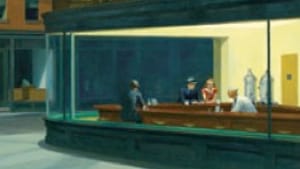Stay in the Loop
BSR publishes on a weekly schedule, with an email newsletter every Wednesday and Thursday morning. There’s no paywall, and subscribing is always free.
Hopper and Turner at National Gallery

Hopper and Turner:
Divergent temperaments with a single obsession
VICTORIA SKELLY
Two important exhibitions are now showing at the National Gallery in Washington D.C. In the East Wing there is Edward Hopper, the American painter of the early to mid-20th Century, and the West Wing features J.M.W. Turner, the 19th-Century English landscape painter. I found this juxtaposition intriguing. Hopper was a modernist and a realist; Turner was a romantic who yearned to elevate landscape as a worthy artistic subject. Yet I detected a common bond between them: Both painters were fascinated with light. Exploring the effects of light or the lack of it was a fruitful, lifelong focus for both men.
Hopper once declared, “My aim in painting has always been the most exact transcription possible of my most intimate impressions of nature.” Through Hopper’s pared lens, one sees a dappling of light against Victorian architecture, such as in Mansard Roof, and then deep-cast shadows in his etchings of his early work. There are horizontal stripings of light and shadow in his New England landscapes, such as Lighthouse Hill, and garish artificial lighting and cast shadows in his urban pictures, such as Automat, Office at Night, Night Windows and the ever famous Nighthawks.
Drama in these pictures
In all Hopper canvases, light or the absence of it is captured in angles, trapezoids, stripes, bars and triangles. One can get lost just looking at these exquisitely composed geometrics of light. Hopper’s rich colors of yellow green, teal, wine red, burnt orange and ochre are paired with more sedate shades of gray and brown to produce a visual zing in his cityscapes. The landscapes find yellow green, ochre and earthy reds paired with cerulean skies and water. His brushstrokes suggest a texture, a sort of furriness of surface that works well in concert with his “tableau” presentation of subject matter, shorn of all extraneous detail.
There is a drama to these pictures, an everyman sort of monumentality to these scenes of New England landscape or the mean streets of New York. Somehow, speculation as to the “story” in the pictures detracts from their power. This is precisely what Hopper intended.
Turner’s dazzling light effects
As for Turner, we learn that he entered the Royal Academy of Arts in London at age 14 to train as an architectural draftsman. Unlike Hopper, who had trained in commercial illustration and loathed the compromised freedom of working for others, Turner embraced the training that he received from “the institution to which I owe everything.” He produced watercolors that expressed the aesthetic of the sublime and the picturesque in landscapes of his travel destinations. His oils also focused on themes of literature, history and contemporary events in landscapes of Britain and Italy.
Light emanates from turbulent skies in his pictures, sometimes so intense as to dissolve most form. Works such as Venice, From the Porch of Madonna della Salute, Ulysses Deriding Polyphemus— Homer’s Odyssey, and— my favorite, from our own Philadelphia collection— The Burning of the House of Lords and Commons, 16th October, 1834, all reveal dazzling light effects.
It’s amazing that Turner had experimented in painting light in this way and at this time in history. Peace, Burial at Sea was painted in 1842 and Lake of Zug: Early Morning, several breaths away from abstraction, was painted in 1843. Claude Monet’s Impression: Sunrise was to be submitted to the first Independent Art Show of the Impressionists in 1874. J.M. Whistler’s wispy Nocturne paintings were painted in the 1870s as well.
These are exhibitions not to be missed.
Divergent temperaments with a single obsession
VICTORIA SKELLY
Two important exhibitions are now showing at the National Gallery in Washington D.C. In the East Wing there is Edward Hopper, the American painter of the early to mid-20th Century, and the West Wing features J.M.W. Turner, the 19th-Century English landscape painter. I found this juxtaposition intriguing. Hopper was a modernist and a realist; Turner was a romantic who yearned to elevate landscape as a worthy artistic subject. Yet I detected a common bond between them: Both painters were fascinated with light. Exploring the effects of light or the lack of it was a fruitful, lifelong focus for both men.
Hopper once declared, “My aim in painting has always been the most exact transcription possible of my most intimate impressions of nature.” Through Hopper’s pared lens, one sees a dappling of light against Victorian architecture, such as in Mansard Roof, and then deep-cast shadows in his etchings of his early work. There are horizontal stripings of light and shadow in his New England landscapes, such as Lighthouse Hill, and garish artificial lighting and cast shadows in his urban pictures, such as Automat, Office at Night, Night Windows and the ever famous Nighthawks.
Drama in these pictures
In all Hopper canvases, light or the absence of it is captured in angles, trapezoids, stripes, bars and triangles. One can get lost just looking at these exquisitely composed geometrics of light. Hopper’s rich colors of yellow green, teal, wine red, burnt orange and ochre are paired with more sedate shades of gray and brown to produce a visual zing in his cityscapes. The landscapes find yellow green, ochre and earthy reds paired with cerulean skies and water. His brushstrokes suggest a texture, a sort of furriness of surface that works well in concert with his “tableau” presentation of subject matter, shorn of all extraneous detail.
There is a drama to these pictures, an everyman sort of monumentality to these scenes of New England landscape or the mean streets of New York. Somehow, speculation as to the “story” in the pictures detracts from their power. This is precisely what Hopper intended.
Turner’s dazzling light effects
As for Turner, we learn that he entered the Royal Academy of Arts in London at age 14 to train as an architectural draftsman. Unlike Hopper, who had trained in commercial illustration and loathed the compromised freedom of working for others, Turner embraced the training that he received from “the institution to which I owe everything.” He produced watercolors that expressed the aesthetic of the sublime and the picturesque in landscapes of his travel destinations. His oils also focused on themes of literature, history and contemporary events in landscapes of Britain and Italy.
Light emanates from turbulent skies in his pictures, sometimes so intense as to dissolve most form. Works such as Venice, From the Porch of Madonna della Salute, Ulysses Deriding Polyphemus— Homer’s Odyssey, and— my favorite, from our own Philadelphia collection— The Burning of the House of Lords and Commons, 16th October, 1834, all reveal dazzling light effects.
It’s amazing that Turner had experimented in painting light in this way and at this time in history. Peace, Burial at Sea was painted in 1842 and Lake of Zug: Early Morning, several breaths away from abstraction, was painted in 1843. Claude Monet’s Impression: Sunrise was to be submitted to the first Independent Art Show of the Impressionists in 1874. J.M. Whistler’s wispy Nocturne paintings were painted in the 1870s as well.
These are exhibitions not to be missed.
Sign up for our newsletter
All of the week's new articles, all in one place. Sign up for the free weekly BSR newsletters, and don't miss a conversation.

 Victoria Skelly
Victoria Skelly